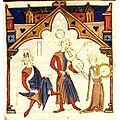Cancioneiro da Biblioteca Nacional facts for kids
The Cancioneiro da Biblioteca Nacional (which means "The National Library Songbook") is a very old collection of songs. It's also often called Colocci-Brancuti. This special book holds many songs written in Galician-Portuguese, a language spoken in parts of Spain and Portugal long ago.
These songs were created by two main types of artists: troubadours, who were usually noble poets and musicians, and jograes, who were skilled performers but not from noble families.
Contents
Types of Songs in the Book
The songs in the Cancioneiro are sorted into three main groups:
- Cantigas de amigo: These are love songs sung from a girl's point of view, often about her boyfriend.
- Cantigas de amor: These are also love songs, but they are sung from a boy's point of view.
- Cantigas de escárnio e mal-dizer: These are funny songs that often make fun of people or situations. They can be a bit cheeky!
How the Songbook Was Made
The Cancioneiro was copied by hand in Italy around the years 1525-1526. A smart person named Angelo Colocci (who lived from 1467 to 1549) ordered the copying. He was a humanist, which means he loved learning and old texts. Colocci carefully numbered all the songs and even made an index (a list of contents) for the book.
The Songbook's Journey
In the 1800s, the Cancioneiro was owned by Count Paolo Brancuti di Cagli in Italy. It was found in his private library in 1878. Later, the Count sold the book to a language expert named Ernesto Monaci. He wanted the book to stay in Italy.
However, in 1924, the government of Portugal bought the manuscript. Since then, it has been kept safely at the Portuguese National Library in Lisbon. There's also a very similar songbook, like a sister or cousin, kept in the Vatican Library. It's called the Cancioneiro da Vaticana.
Who Wrote the Songs?
The Cancioneiro was copied by six different people, using both old-fashioned gothic writing and a more flowing cursive style. Originally, it had 1664 songs, but now about 1560 remain.
Many famous poets and even kings wrote songs in this collection. Some of them include:
- King Dinis of Portugal
- King Sancho I
- D. Pedro, Count of Barcelos
- Pay Soares de Taveirós
- Johan Garcia de Guilhade
- Johan Airas de Santiago
- Airas Nunes
- Martin Codax
In total, there are about 160 different poets whose songs are in this amazing book!
See also
Images for kids


